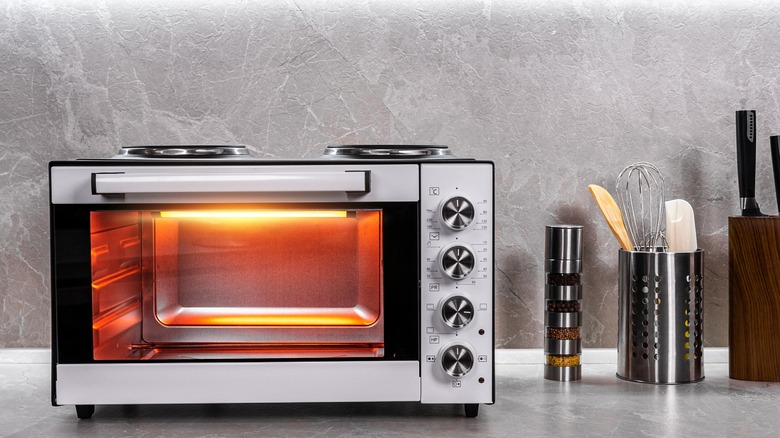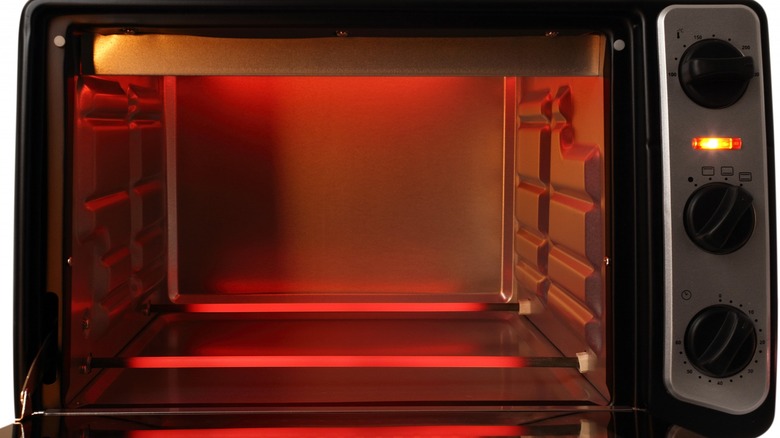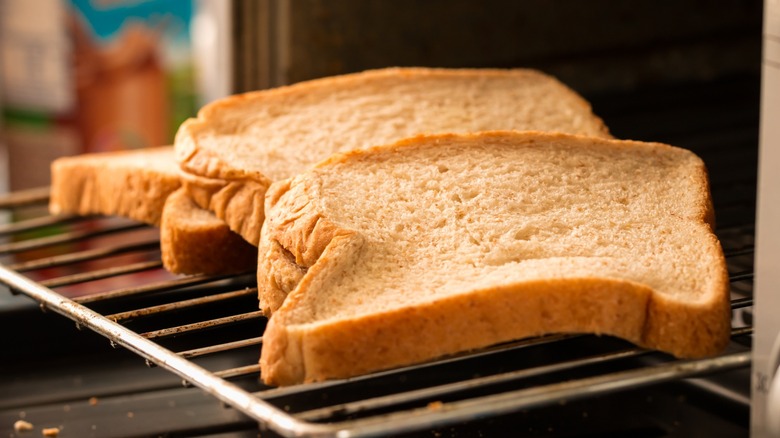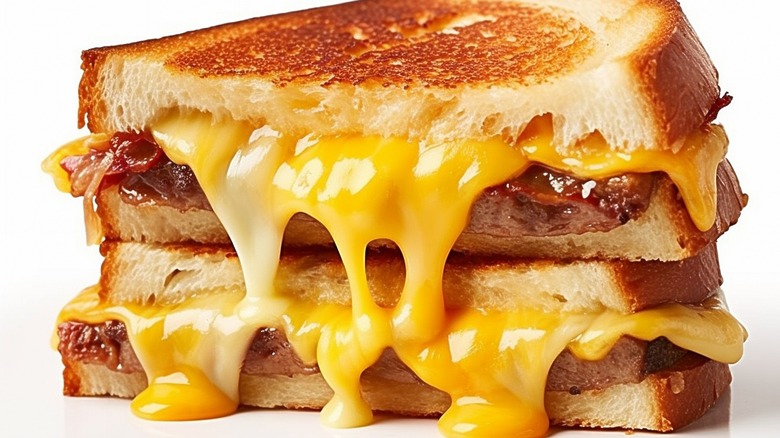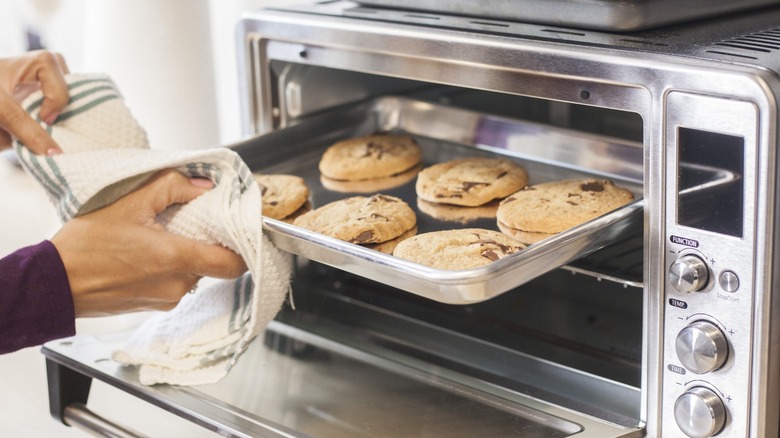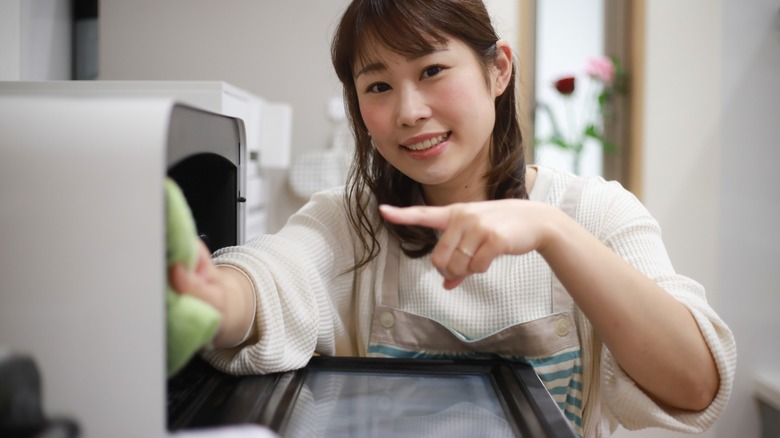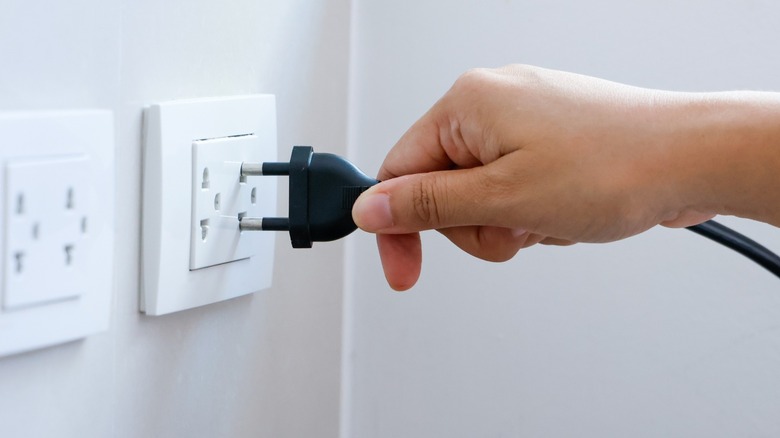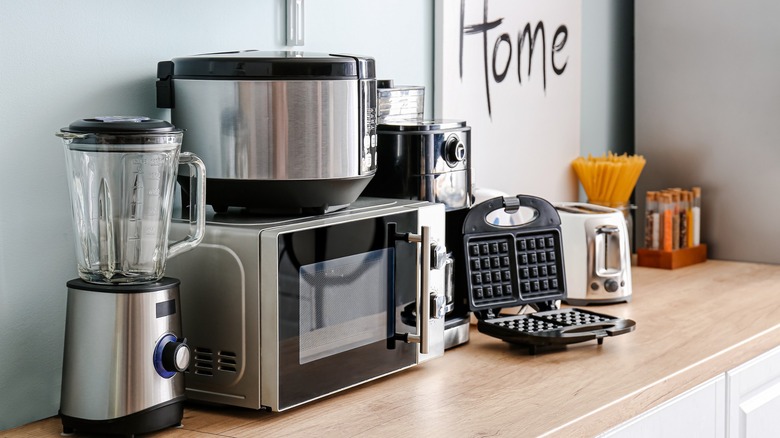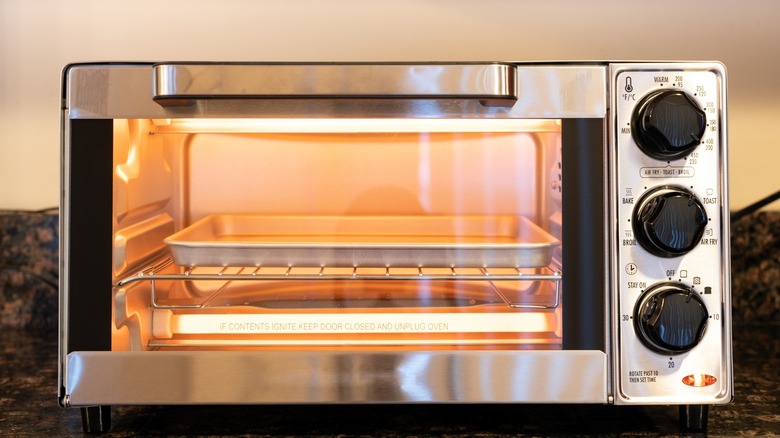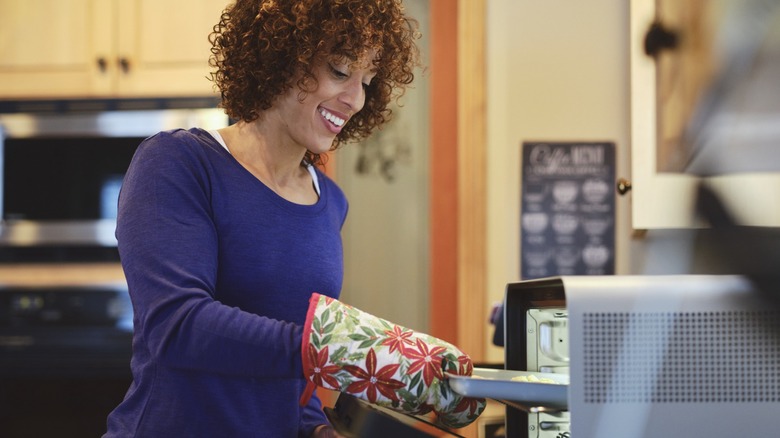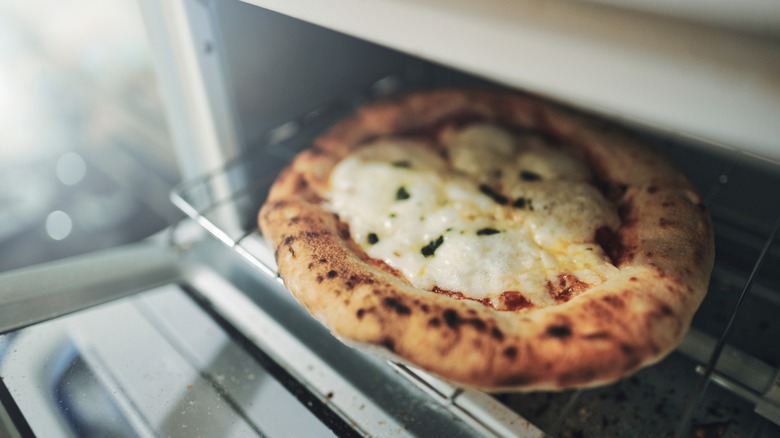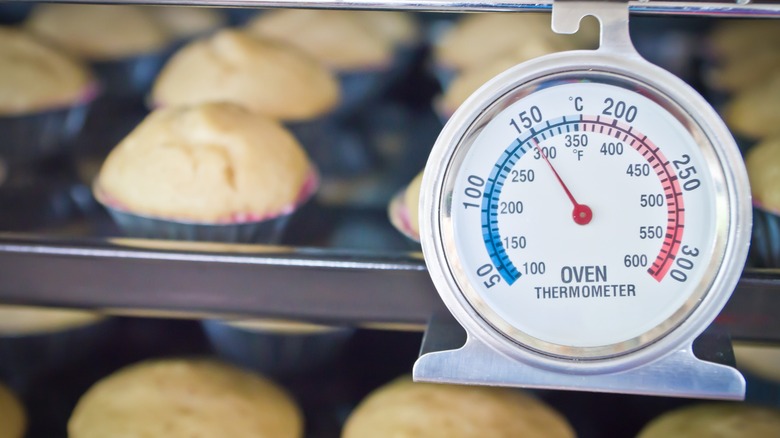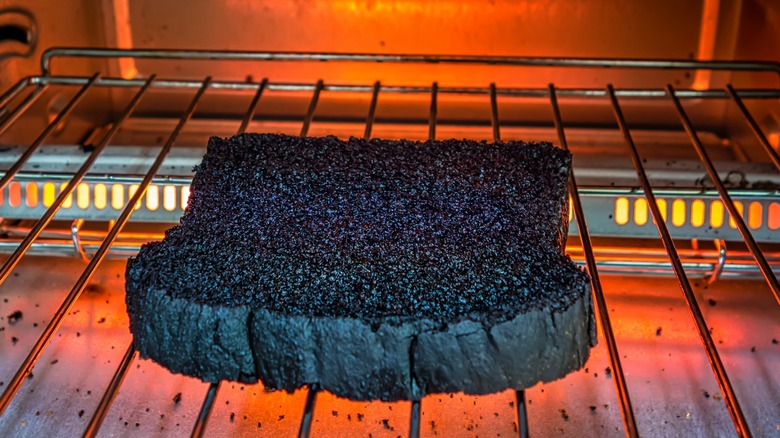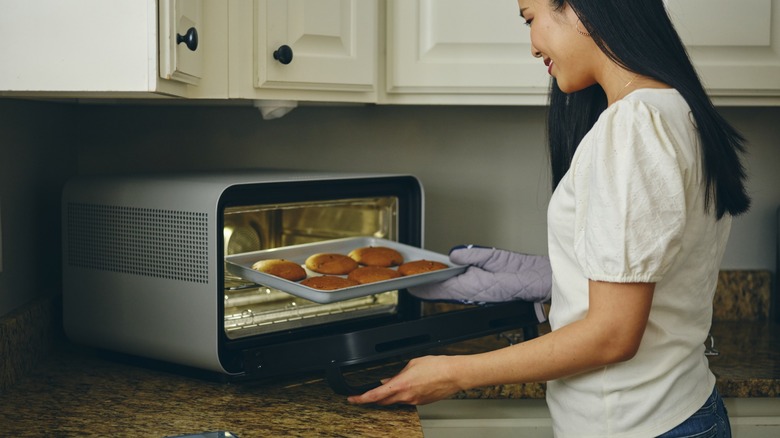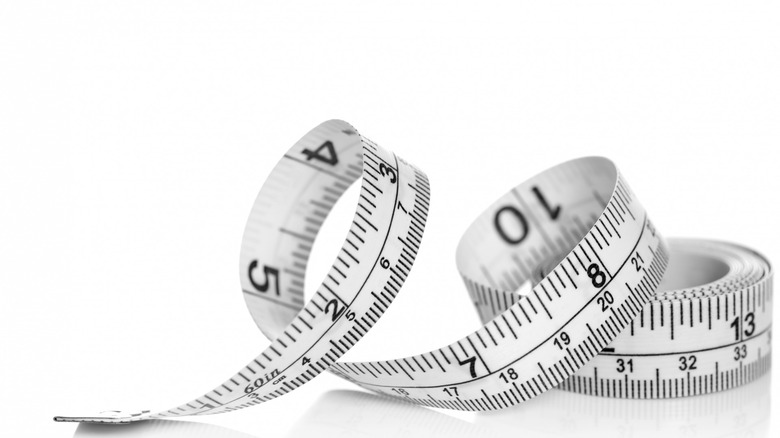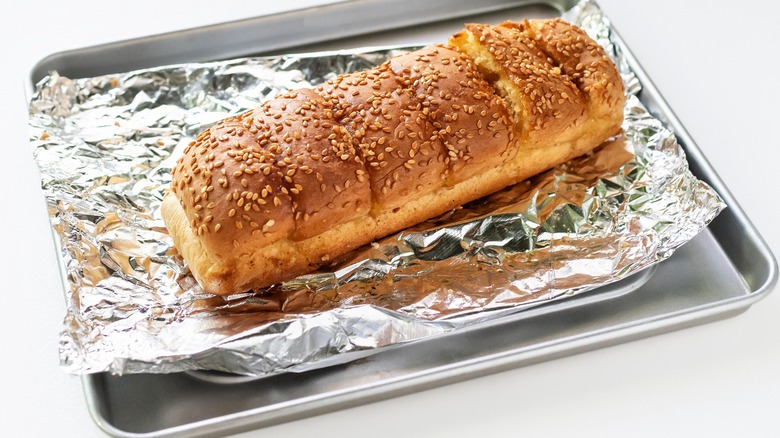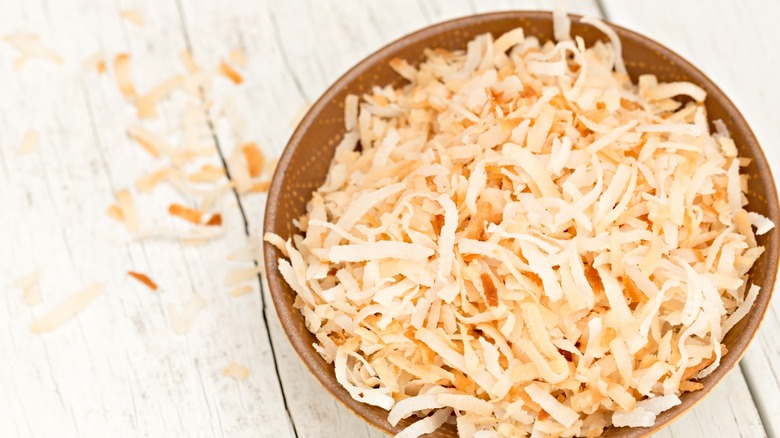16 Common Mistakes People Make With Toaster Ovens
A toaster oven may seem like a pretty simple appliance to use, but think again. With every model packing a variety of different settings — and so many different makes and models out there to choose from — there's a bit more to the humble toaster oven than you'd expect.
The average toaster oven is great for making toast, and toasted sandwiches — that much is true. But some models can also broil, bake, fry, and even cook entire meals from scratch, as well as keeping your food warm. Whether you use your toaster oven a couple of times a month to bake cakes and muffins, make toast in it on the daily, or cook all your meals in it, there are sure to be some mistakes you're making — and you're not alone.
We've rounded up 16 of the most common mistakes people make with toaster ovens right here. As well as pointing out the mistake, we'll explain why it's such a bad idea and what to do instead.
1. Not preheating it
One of the best things about a toaster oven is that it doesn't need preheating like your regular oven, right? While it's not essential to preheat your toaster oven, doing so ensures that everything you prepare cooks at the correct temperature for the right time, so you'll be less likely to end up with undercooked or burnt food.
Some toaster oven models will show when they're preheating, and let you know once the desired temperature has been reached. For others, you can use a timer and set it for around five minutes to preheat your oven. Because it's small, it heats up faster than a regular oven, so you'll be ready to cook in no time!
Just making a few slices of toast or keeping food warm? Then there's no need to preheat. However, it's particularly important to preheat your oven if you're baking and want perfectly risen biscuits or a beautifully flaky pie crust.
2. Overcrowding it
Toaster ovens have more space than you get in an air fryer, but that doesn't mean that overfilling your oven is a good idea. When you're buying a new toaster oven, always check the capacity to ensure you're choosing one that's the right size for your needs, as they can vary.
Overcrowding your oven by squeezing in too many slices of toast or piling things high means the food won't cook evenly or consistently. Steam becomes trapped under food, which can lead to soggy results rather than the deliciously crispiness you were expecting.
Even worse, overfilling your toaster oven could cause it to overheat, which is a fire hazard. Make sure you're only filling it to capacity and that there's plenty of space for air to circulate around food.
3. Cooking the wrong things in it
If you're lucky enough to have a multi-functional toaster oven, you can cook all kinds of things in it. However, there are some things that it's not a great idea to prepare in it. Overly fatty and greasy foods such as bacon are a bad idea. These could drip onto exposed heating elements and start a fire. That said, if you are cooking something that might drip, such as bacon or grilled cheese, we'd recommend using a lined baking sheet or popping one underneath the item as it bakes to catch any drips that could fall onto the heating elements.
Rice or pasta can't be cooked in your toaster oven, either. These require boiling water, so you'll need to prepare them on the stove. Most things that you can make in a regular oven, you can cook in your toaster oven — think baked potatoes, fries, roast vegetables, toast, pizza rolls, chicken nuggets, and baked goods from bagels to biscuits and pies.
4. Not using the right bakeware
Bakeware that's oven-safe is usually fine to use in your toaster oven, but there are some things you need to be aware of. Never use glass or ceramic dishes that could crack or splinter in your oven. Even those marketed as "oven-safe" might not be a good idea to use, as your dishes are much closer to the heating element than in a conventional oven. There's plenty of bakeware out there that's especially designed for toaster ovens, from baking sheets to round cake tins and loaf pans, and you can use these in your regular oven, too.
Rather than ceramic or glass, opt for steel or aluminum bakeware. Not only is it safe to use in your toaster oven, it's also easy to clean and care for, and if you choose dishwasher-safe bakeware, cleaning up after baking will be a breeze! Don't just rush out to stock up on bakeware as soon as you've bought your new appliance, though. Take some time to figure out what you enjoy cooking and baking in it, so that you know what bakeware is best to invest in.
5. Forgetting to clean it, including the crumb tray
Just like any other appliance, your toaster oven needs regular cleaning. It's best to clean it after each use so it functions at its best and to avoid burnt on food that's hard to remove later. While some toaster ovens have dishwasher-safe parts making cleanup a breeze, for others you'll need to resort to handwashing. Don't forget to empty and clean the crumb tray. It's recommended to do this on a daily basis to avoid overheating, which could pose a fire risk.
Before cleaning your toaster oven, always unplug it first, then remove and soak any accessories. Use warm water with a little soap and a soft cloth to clean inside of it, then use a clean damp cloth to rinse; always avoid the heating elements.
6. Leaving it unattended or plugged in
Speaking of fire hazards, leaving your toaster oven unattended while in use, or plugged in after you've finished using it, is a bad idea. The outside of it, including the glass door, can get very hot and could burn kids or pets. If your tabletop oven has other items crowded next to it on a countertop, it could overheat and cause a fire, so make sure it has good air circulation around it.
According to 2024 Market Data Report from Gitnux, around 1,330 fires are caused each year by toaster ovens, with almost 50% of those fires caused by malfunctions or electrical failures. To avoid the risk of fire, always keep an eye on your appliance while cooking, as if it develops an electrical fault it could spark or smoke. Make sure you're not plugging too many appliances into the same circuit and always unplug it when not in use.
7. Storing things on top of it
As we mentioned, air circulation is important to prevent your toaster oven from overheating and causing a potential fire. We get that storage space might be at a premium in your studio apartment kitchen, but piling things on top of your toaster oven isn't the solution!
Whether you store your air fryer or rice cooker on top of your toaster oven or even use it as a place to stash plates and silverware, it's a bad idea. Some manuals for the most common models advise against doing this, as the outside of the ovens can get very hot and items could overheat, burn, or melt.
8. Sticking to just one setting
How many settings does your toaster oven have? It's easy to get stuck using the same one on repeat, particularly if you have a few go-to meals that you always make. But playing around with all those settings and using your toaster oven to its full potential is part of the fun!
The broil setting is like a grill, with heat coming from the top of the oven. It's great for caramelizing sugar on that creme brulee, melting cheese, or cooking perfectly crispy chicken. Always place food on the highest rack, ensuring it isn't touching the top element. Most toaster ovens also have a toast function, which, as the name suggests, is great for toasting bread and other items as well as making grilled cheese.
The bake function is the one you want for pies, cookies, bagels, brownies, and any other baked goods you feel like making. Don't forget about the warm setting.
9. Using metal implements or your hands to retrieve food
Toaster ovens get just as hot as conventional ovens, so never reach into them with your bare hands — always use an oven glove or mitt. Don't be tempted to use silverware or metal utensils in your toaster oven. These ovens emit an electric current, so metal acts as a condcutor and could result in a serious electric shock.
According to the U.S. Consumer Product Safety Commission, 61 people died as a result of electrocution caused by small appliances, including toaster ovens, between 2004 and 2013. Stay safe and opt for silicone tongs without any metal elements, or, even better, wooden tongs or a wooden spatula.
10. Not using it to warm food
We already mentioned the warm setting on your toaster oven — but are you guilty of never using it? Toaster ovens aren't just great for cooking, they're also the perfect way to reheat leftovers or keep food warm. If you're preparing a huge spread for Christmas or Thanksgiving, the warming function is your best friend. Keep veggies, gravy, and other side dishes warm for around 20 to 30 minutes while your roast chicken cooks in the main oven!
The warming function also comes into its own when you're making several batches of pancakes at breakfast time. Keep the first batch toasty while whipping up the others, so nobody has cold pancakes. Or use your toaster oven to reheat day-old pizza or chicken for deliciously crispy results.
11. Not checking the temperature
Every kitchen appliance is different, and although your oven says it's reached a specific temperature, you can't always rely on the dial. A toaster oven is no different, and you might be surprised by how much the temperatures vary from what you are expect.
An experiment by Toaster Oven Love revealed discrepancies with several toaster oven models. In some cases, moving the toaster ovens away from the wall and giving it more breathing room solved the problem. In other cases, writers needed to adjust cooking times to suit their individual ovens. Want to see if your oven's temperature dial is accurate? It's a good idea to invest in an oven thermometer to check.
12. Turning the heat up too high
Though it can be tempting to crank the temperature up high on your toaster oven to ensure crisp food, don't forget that most toaster ovens are convection ovens with a fan. If your oven has a fan, you'll need to reduce the cooking temperature by 25 degrees — or look for the recommended fan oven setting when following recipes. Most convection models also have the option to turn the fan setting off, if you prefer to cook using conventional oven settings.
Always check on your food as it cooks, as every oven is different and it may cook faster in a toaster oven than you'd expect. If in doubt, start out with a lower temperature, as it's easier to turn it up later than it is to rescue burnt food.
13. Buying the wrong oven for your needs
With so many different models available, it can be hard to find the best toaster oven and buying the wrong one for your needs is an all-too-common mistake. Before you head out to buy one, think about the settings you need, what you want to cook, how large a capacity you need — i.e., how many people you'll be cooking for — and any other features you want.
Other things to consider are how noisy an oven is, how easy it is to clean — does it have dishwasher-safe parts? — and its design and size, to ensure it fits in your kitchen. If you have kids or pets, you might want to look for a toaster oven with a cooler surface temperature to avoid the risk of burns.
If you only plan to make toast and grilled cheese in your toaster oven, you can opt for a more basic, budget-friendly model. Don't forget to consider the cord length and where power outlets are in your kitchen, too.
14. Buying the wrong size pans
Not all toaster ovens are created equal! You might think if you pick up pans or bakeware specifically designed for a toaster oven that it will automatically fit in yours, but they're all different sizes. That's why it's important to measure first to avoid buying ones that won't fit in your oven.
Use a tape measure to size up the length, height, and depth of your toaster oven before shopping for bakeware. Remember that dishes shouldn't touch the walls or door of the oven, as air needs to circulate, so choose pans slightly smaller than the inside of your oven.
15. Using foil in your toaster oven
You might think that foil is a great way to protect your bakeware and catch drips and spills in your toaster oven, but hold up! It's not recommended for use in all toaster ovens, so you should check the manual.
Foil that isn't fitted securely to a pan or sheet runs the risk of coming into contact with the heating element or walls of your toaster oven. This could cause a fire risk from overheating. So while it might be okay to use foil in your toaster oven, always check first, and if you do use it, ensure it's secured to your bakeware.
16. Only using the toast setting for bread
Toaster ovens, as the name suggests, can toast things! But don't fall into the trap of thinking that the only thing you can toast is bread. It's also great for grilled cheese or other toasted sandwiches, as well as bread-adjacent items like bagels or wraps.
Baked goods aside, you can toast coconut in your toaster oven and use it to top everything from muffins and stir fries to oatmeal and white hot chocolate. You can even toast nuts or make candied pecans for use in all your favorite recipes or as a snack. Just make sure to keep an eye on items while they're toasting, as they can quickly go from golden brown to burnt!
